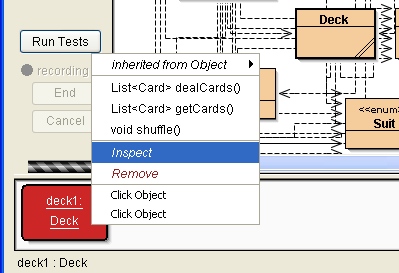
import java.lang.reflect.*;
public class DumpMethods
{
public static void main(String args[])
{
try {
Class target = Class.forName(args[0]);
Method methodList[] = target.getDeclaredMethods();
for
(int i = 0; i < methodList.length; i++)
{
System.out.println(methodList[i].toString());
}
}
catch (Throwable e) {
System.err.println(e);
}
}
}
java DumpMethods java.util.Stack
yields the output:
public java.lang.Object java.util.Stack.push(Could we use reflection in the Plugins Lab?
java.lang.Object)
public synchronized
java.lang.Object java.util.Stack.pop()
public synchronized
java.lang.Object java.util.Stack.peek()
public boolean java.util.Stack.empty()
public synchronized
int java.util.Stack.search(java.lang.Object)
package Reflection;
import java.lang.reflect.Constructor;
import java.util.TreeSet;
import java.util.Arrays;
import java.util.Collection;
import java.util.AbstractSet;
public class CreateInstance
{
/** Production code should catch all exceptions */
@SuppressWarnings("unchecked") // Warning - reflection is dangerous
public static void main(String args[]) throws Throwable
{
Class stringClass = java.lang.String.class;
// creating an object with no arguments: String()
String myString = (String) stringClass.newInstance();
myString = "Hello World";
System.out.println("My String:" + myString);
// creating an object with multiple arguments: String(char[] value, int offset, int count)
Constructor constructor = stringClass.getConstructor(new Class[] { char[].class, int.class, int.class });
char[] word = {'M','y',' ','w','o','r','d'};
myString = (String) constructor.newInstance(new Object[] { word, 3, 4 });
System.out.println("My String:" + myString);
// creating an object with one argument that's an Object: TreeSet(Collection c)
Class setClass = java.util.TreeSet.class;
constructor = setClass.getConstructor(new Class[] { Collection.class });
String[] words = {"one","two","three"};
Object[] arguments = new Object[1];
arguments[0] = Arrays.asList(words);
TreeSet mySet = (TreeSet) constructor.newInstance(arguments);
System.out.println("My Set:" + mySet);
// create an object for a class whose name we don't know at compile time
Class someClass = Class.forName(args[0]);
Object someThing = someClass.newInstance();
// If the class is supposed to be derived from a base class (like java.util.TreeSet)
AbstractSet aSet = (AbstractSet) someClass.newInstance();
aSet.add("able");
System.out.println("A Set:" + aSet);
}
}